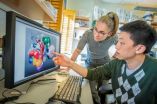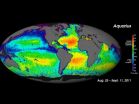(Press-News.org) Research indicates that half of all lifetime cases of mental illness begin by age 14, well before adulthood. Three new studies investigate the cognitive, genetic and environmental factors that may contribute to mental health disorders in adolescence. The studies are published in Psychological Science and Clinical Psychological Science, journals of the Association for Psychological Science.
Social-Information-Processing Patterns Mediate the Impact of Preventive Intervention on Adolescent Antisocial Behavior
Kenneth A. Dodge, Jennifer Godwin, and The Conduct Problems Prevention Research Group
Fast Track is a preventive intervention designed to help children who show aggression at an early age. The intervention addresses kids' social-cognitive processes in several ways, including social-skill training groups, parent groups, and classroom curricula. In this study, the researchers investigated the processes underlying this intervention's success. A total of 891 kindergarteners who were at high risk for adolescent antisocial behavior were randomly assigned to receive either the Fast Track intervention or a control program. The data revealed that children in the intervention showed decreased levels of antisocial behavior at the end of 9th grade, which was driven, in part, by improvement on three specific social-cognitive processes. These results suggest that social-cognitive processes may play an important role in the development of antisocial behavior in youth.
Published online February 13, 2013 in Psychological Science
A Comparison of Two Models of Urgency: Urgency Predicts Both Rash Action and Depression in Youth
Gregory T. Smith, Leila Guller, and Tamika C.B. Zapolski
Smith and colleagues test two competing theories concerning the trait of urgency. One theory posits that urgency reflects the people's tendency to act rashly or impulsively when they're emotional. Another theory suggests that urgency reflects a general responsiveness to emotions that can lead to rash action (such as heavy drinking or binge eating) or ill-advised inaction (which is associated with symptoms of depression). In previous research, Smith and colleagues found that urgency levels in 5th grade predicted addictive behaviors (including alcohol consumption, binge eating, and smoking) in 6th grade, which is consistent with both theories. In this study, the researchers found that level of urgency in 5th grade also predicted higher levels of depression at the end of 6th grade. These results support the view that urgency can lead either to rash action or ill-advised inaction. The researchers conclude that urgency may be an important trait in various diagnoses, across both internalizing and externalizing disorders.
Published online February 15, 2013 in Clinical Psychological Science
Genetic and Environmental Influences on Rumination, Distraction, and Depressed Mood in Adolescence
Mollie N. Moore, Rachel H. Salk, Carol A. Van Hulle, Lyn Y. Abramson, Janet S. Hyde, Kathryn Lemery-Chalfant, and H. Hill Goldsmith
About one in 10 adolescents will experience major depression or dysthymia by age 18. Rumination, the process of dwelling on one's feelings and problems, is an established cognitive risk factor for depression. In this study, Moore and colleagues investigated whether response styles associated with rumination might account for some of the genetic vulnerability associated with depression. A total of 756 adolescent twins ages 12 to 14 completed the Response Styles Questionnaire and several measures of depressive symptoms. Brooding was positively correlated with depressive symptoms, while distraction was negatively correlated with the symptoms. About 54% of the variation in depression symptoms could be attributed to genetic variation, while 37% of the variation in reflection and 30% of the variation in distraction were accounted for by genetic variation. Further analyses showed that individual differences in distraction share both genetic and environmental sources of variation with depression. Together, these results suggest that the same genetic factors that contribute to distraction may protect against depression.
Published online February 20, 2013 in Clinical Psychological Science
### END
Research explores factors that impact adolescent mental health
2013-02-28
ELSE PRESS RELEASES FROM THIS DATE:
NuSTAR helps solve riddle of black hole spin
2013-02-28
An international team including Lawrence Livermore National Laboratory scientists has definitively measured the spin rate of a supermassive black hole for the first time.
The findings, made by the two X-ray space observatories, NASA's Nuclear Spectroscopic Telescope Array (NuSTAR) and the European Space Agency's XMM-Newton, solve a long-standing debate about similar measurements in other black holes and will lead to a better understanding of how black holes and galaxies evolve.
"We can trace matter as it swirls into a black hole using X-rays emitted from regions very ...
First grade math skills set foundation for later math ability
2013-02-28
Children who failed to acquire a basic math skill in first grade scored far behind their peers by seventh grade on a test of the mathematical abilities needed to function in adult life, according to researchers supported by the National Institutes of Health.
The basic math skill, number system knowledge, is the ability to relate a quantity to the numerical symbol that represents it, and to manipulate quantities and make calculations. This skill is the basis for all other mathematics abilities, including those necessary for functioning as an adult member of society, a ...
A game plan for climate change
2013-02-28
Researchers have successfully piloted a process that enables natural resource managers to take action to conserve particular wildlife, plants and ecosystems as climate changes.
The Adaptation for Conservation Targets (ACT) framework is a practical approach to assessing how future changes in air and water temperatures, precipitation, stream flows, snowpack, and other environmental conditions might affect natural resources. ACT enables scientists and managers to work hand-in-hand to consider how management actions may need to be adjusted to address those impacts.
"As ...
Changing shape makes chemotherapy drugs better at targeting cancer cells
2013-02-28
(Santa Barbara, Calif. –) Bioengineering researchers at University of California, Santa Barbara have found that changing the shape of chemotherapy drug nanoparticles from spherical to rod-shaped made them up to 10,000 times more effective at specifically targeting and delivering anti-cancer drugs to breast cancer cells.
Their findings could have a game-changing impact on the effectiveness of anti-cancer therapies and reducing the side effects of chemotherapy, according to the researchers. Results of their study were published recently in Proceedings of the National Academy ...
Retailers should re-size maternity wear for women throughout their pregnancies, MU study finds
2013-02-28
COLUMBIA, Mo. — Fashion retailers have seen an increase in demand for maternity wear in recent years, as sales for maternity clothing have increased while overall women's apparel sales have declined. Currently, most retailers produce maternity wear using a standardized size chart that begins with women in their seventh month of pregnancy. Retailers produce garments for women who are earlier in their terms by adjusting the sizes smaller proportionally based on the standardized chart. In a recent study, University of Missouri researcher MyungHee Sohn, an assistant professor ...
Reading the human genome
2013-02-28
Researchers with the U.S. Department of Energy (DOE)'s Lawrence Berkeley National Laboratory (Berkeley Lab) have achieved a major advance in understanding how genetic information is transcribed from DNA to RNA by providing the first step-by-step look at the biomolecular machinery that reads the human genome.
"We've provided a series of snapshots that shows how the genome is read one gene at a time," says biophysicist Eva Nogales who led this research. "For the genetic code to be transcribed into messenger RNA, the DNA double helix has to be opened and the strand of gene ...
Workstation design improvements for drone operators may reduce costs & mishaps, researchers suggest
2013-02-28
The U.S. Department of Defense reports that drone accidents in which personnel or aircraft are damaged or destroyed occur 50 times more often than mishaps involving human-operated aircraft. The U.S. Marines and Army reported 43 mishaps that involved human factors issues associated with drone ground control workstations and technology during 2006−2007.
Human factors/ergonomics (HF/E) researchers Qaisar Waraich, Thomas Mazzuchi, Shahram Sarkani, and David F. Rico suggest that multimillion-dollar drone losses might be prevented if long-established and broadly applied ...
Protein balance key in preventing cancer
2013-02-28
PHILADELPHIA, PA (February 27, 2013)—Two proteins that scientists once thought carried out the same functions are actually antagonists of each other, and keeping them in balance is key to preventing diseases such as cancer, according to new findings published in the February 25 issue of Developmental Cell by scientists at Fox Chase Cancer Center. The results suggest that new compounds could fight cancer by targeting the pathways responsible for maintaining the proper balance between the proteins.
"It's our job now to understand how we can intervene therapeutically in ...
NASA's Aquarius sees salty shifts
2013-02-28
The colorful images chronicle the seasonal stirrings of our salty world: Pulses of freshwater gush from the Amazon River's mouth; an invisible seam divides the salty Arabian Sea from the fresher waters of the Bay of Bengal; a large patch of freshwater appears in the eastern tropical Pacific in the winter. These and other changes in ocean salinity patterns are revealed by the first full year of surface salinity data captured by NASA's Aquarius instrument.
"With a bit more than a year of data, we are seeing some surprising patterns, especially in the tropics," said Aquarius ...
GSA Today: Putting time in its place
2013-02-28
Boulder, Colorado, USA – In the March issue of GSA Today, seven scientists from six countries, led by Jan Zalasiewicz of the University of Leicester, propose a realignment of the terms "geochronology" and "chronostratigraphy" in an attempt to resolve the debate of whether units of the Geological Time Scale should have a single (time) or dual (time and time-rock) hierarchy.
In their system, which retains both parallel sets of units, with an option to adopt one or other when appropriate, geochronology refers to all methods of numerical dating and is used to express the ...




